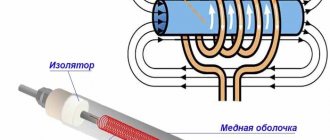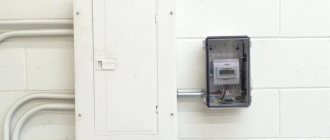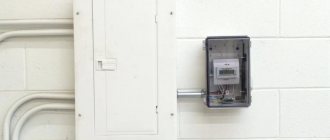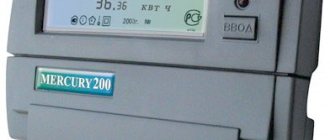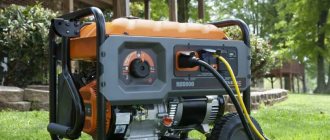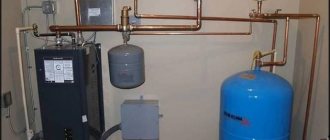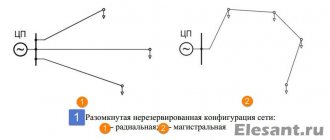Principle of operation
Uninterruptible power supplies for a private home
The principle of operation is that in the presence of an external power supply network, the inverter passes voltage to consumers, while the charger built into it recharges the battery. When the power supply goes out, the inverter instantly switches to operation from batteries and converts their direct voltage into alternating voltage.
According to their purpose, electricity storage devices are divided into 2 categories:
- uninterruptible power supply (UPS) to ensure the operation of household electrical appliances;
- uninterruptible power supply for the home in case of a power outage.
Products vary in composition, size, power, cost and discharge duration. They can be located both inside the building and outside it in separate buildings.
UPS or generator?
A backup power source is necessary for life support at home: heating, routers, computers, servers, smart home systems. Both generators and UPS with batteries can provide the minimum required to maintain the operation of devices. Let's see which one will be more convenient to use.
First of all, the backup power source is required to provide instantaneous voltage when the permanent source is turned off. The generator cannot boast of such speed: it takes from 10 seconds to 2.5 minutes to accelerate. The UPS switches to operating mode in 4 ms, as a result, sensitive equipment retains settings without entering restart mode. Double conversion inverters do not require any time to supply voltage - they are always on and immediately start working after a power outage.
Inverters have no mechanical parts subject to wear. The main factors affecting the resource are battery capacity and power consumption. This system is convenient both during short periods of power supply from the main one, and during long power outages for several days. The batteries will immediately begin to power the security alarm or heating of the house.
Unlike a generator, the UPS operates very quietly, without emitting any gases into the environment. The generator runs on fuel, and you can get rid of exhaust gases only by moving the unit away from your home. To install a UPS with batteries, you will need a small room with normal humidity levels. A positive temperature is recommended for operation, but some systems also operate at sub-zero thermometer readings.
How to choose a battery for your home
If turning off the lights becomes a constant occurrence, you should think about purchasing an electricity storage device for your home. A computer battery will not solve the problem, as it has a limited resource. We need devices that can ensure the normal functioning of people for several hours, or better yet, days. Such a technical helping hand will come in handy during large-scale accidents on the line.
The selection criteria are as follows
- complexity of installation and commissioning;
- cost of delivery and special services;
- resistance to changes in temperature and humidity;
- Efficiency in modern devices reaches 98%;
- service life - 5000-10000 m/h;
Uninterruptible power supply SVEN RT-500 - overload capacity (withstanding the load when starting the generator) - 200-300%;
- automatic start time - a good energy storage device for the home during a power outage begins the conversion process within 10 ms;
- ability to work at low loads;
- autonomy - a tank designed for a day of engine operation;
- current quality - high-quality energy storage devices produce current with a deviation from industrial values of no more than 2%;
- number of charge-discharge cycles - at least 500;
- power - based on consumers with a margin of 30%, but not less than 6 kW;
- noise produced - inverters operate silently.
Modern high-power electrical energy storage devices can provide a home with energy for 1-2 days. When the power supply is restored, there is no need to turn them off; everything happens automatically.
UPS for home. Kits with high-capacity external batteries
UPS kit for home HPS30 5kW +4 batteries 100ah each + cabinet
UPS kit Hiden HS20-5048 5kW+4*100ah+cabinet
for home Stark 5000 INV with 4x100Ah battery
UPS 5000W On-Line + 4x100Ah Leoch.
5 kW - is it a lot or a little?
When choosing the kit you need, consider:
- The UPS is placed in a break in the power supply circuit of the entire house and in the “operation from the network” mode it will be loaded in total by all the switched on load, and its power must withstand it! Otherwise, everything that you can turn on at the same time (don’t forget about the lawn mower, electric grill and hammer drill) will all be connected to the UPS. Obviously, in the event of a power failure, unnecessary devices will not be used, but the rest of the time, large currents will flow through it. Therefore, with a single-phase connection, the choice of 5-6 kW is needed primarily for operation in normal mode, and in the “battery power” mode, 500-1500 W will actually be used for the really necessary equipment (boiler, refrigerator, pump). And powerful low-frequency UPSs cope with this task perfectly.
- There is no need to count on long-term autonomous operation from the backup power system of electric heaters, water heaters, and air conditioners. This is a waste of money - operating a 3 kW heating element from batteries for 1 hour will cost 400 Ah (four 100 Ah batteries). A generator can handle this task better and cheaper.
Three phase kits. Power 3/5 kW per phase
three-phase UPS kit for home 9kW 3*3kWt+6 batteries 100ah each
If you take a flexible approach to solving the problem of uninterruptible power supply, you can significantly reduce the cost. And at the same time increase the reliability and degree of protection of equipment. This requires knowing where everything is turned on in the house and in what phase the boiler, pumps, sockets and lighting “hang”. If such information is available and it is reliable, then we suggest using not identical UPSs in terms of power, but different ones, combining power consumers into groups:
- The first group, the most important, is heating. Gas boiler with circulation pumps, gas valve and all control electronics. Typically, the power of this system is no more than 500 W, and the requirements for power supply quality are increased. Gas boilers cannot tolerate voltage surges and to protect them, they need On-Line class devices with a power of up to 900 W, but double conversion, which will provide 100% protection against voltage surges, plus two batteries with a capacity of 50 to 100 Ah. Thus, the boiler will have its own battery bank, which will not be used by any other electrical consumer in the house. View optimal solutions for powering and protecting heating boilers.
- The second group, borehole pumps, drainage pumps, refrigerators, microwave ovens, coffee machines, everything that turns on occasionally, but at the same time has high starting currents. For this group you need to install the most powerful UPS (3-6 kW), with a battery of at least 100 Ah. Here, battery capacity is limited only by budget.
- The third group is light. The opportunity to save money comes from using LED lamps. With a total possible power of 1000 W, a powerful inverter is not needed, and the battery is sufficient for up to 100 Ah.
Thus, all three groups will have different batteries, different UPS power, and an accurate calculation will save up to 40-50% compared to the kits above!
Large home battery
The large home battery, produced in Russia by Ekomotors, is an inexpensive and effective analogue to the Tesla PowerWall drive. The product is used for backup power supply to private houses, cottages, offices and other facilities that can be cut off from electricity at any time. It can also be installed in caravans, cabins and mobile canteens. The device stores energy at low rates at night. It has compact dimensions and can be mounted on the wall in a vertical or horizontal position.
Specifications:
- capacity - 7.8 kW/h;
- battery voltage - 24 V;
- power - 7.2 kW;
- dimensions - 1000×500×250 mm;
- weight - 100 kg;
- number of cycles - 7000.
The operation and status of the device is monitored using an Android tablet with the ability to display information on a PC or cell phone.
Batteries for solar battery
If you use solar energy at home, then batteries will be very important to you. They play the role of an intermediary, transferring the received energy power to the end devices and providing the required voltage of 220V.
The solar battery produces the greatest amount of energy during the day when the sun is shining brightly. At night, when energy consumption does not occur, household appliances and various sources of artificial lighting begin to be used very widely. You need a battery to make sure there is enough electricity to last through the night, when recharging will no longer occur.
Statistics say that it is cheaper to use Chinese-made lithium batteries and lead-acid batteries.
The most important battery parameters are as follows:
- Volume. It is determined by how large the charge is measured during the release of electricity to the final consumer devices.
- Energy density. According to this characteristic, it is calculated how much energy the batteries produce per unit of volume or weight. Using this parameter, you can compare the degree of effectiveness of different models.
- Self-discharge. Using this indicator, you can analyze how much energy the device loses when idling, and how long it can store energy.
In order to enjoy environmentally friendly sources of electricity and the necessary 220V all year round, you must comply with the following operating conditions:
Unfortunately, batteries do not withstand sudden temperature changes very well; it is better for them not to stand in heat above +40°C or in cold below –25°C.
It is better not to place these devices near open flames: the vapors may ignite. It is advisable that water and precipitation do not get on the battery: due to the emergence of new electrical circuits, self-discharge currents may occur.
Rechargeable batteries are also characterized by different housing designs. Some require constant monitoring of the electrolyte and replenishing its level when the vapors boil off.
Accumulator battery
There are also hermetically sealed models that use a closed-loop cycle. Some manufacturers offer maintenance-free models and provide a warranty of up to 5 years. Low-maintenance models are also produced, which only require adding water twice a year.
Electricity storage for home
systems Storage systems for a private home can provide power for 24-48 hours. This indicator depends on the completeness of charge, the number of consumers and battery capacity.
The following types of batteries are used:
- Lead-acid. Inexpensive, hold a charge well and quickly reach full power.
- Lithium-ion. They are characterized by low weight, low self-discharge and high capacity.
The choice is determined by your own needs and financial capabilities.
Which battery to choose
When deciding what kind of power source you need to provide the usual 220V in your country house, make a calculation and make sure that it matches the system load. If the current value is exceeded beyond measure, overheating occurs and the batteries fail faster. So, a typical home system is 9 kW, voltage is 24V. If the system works at full capacity, the current will be more than 400A, which will quickly damage the battery plates.
Here you will need batteries with a voltage of 48V. This will reduce the operating current by half, it will be 200A. In addition, it is advisable to use high quality wire connections of all elements; the wire cross-section should not be less than 75 mm2. If these requirements are met, the inverter system will last a long time.
Battery for inverter
Generally speaking, price is the main indicator of the quality of batteries. Is it possible to save money by ensuring good quality? The best way to do this is not to purchase the entire system at once, but to gradually increase capacity. First, we purchase a 3 kW inverter and add new ones to it, because modern technologies make it possible to connect up to 10 identical inverters.
Storage device
Electricity storage devices for home and garden are a system consisting of two functional units that perform a specific task:
- Battery pack. Designed to store energy from an industrial network, fuel or wind generator, solar panel or water turbine.
- Autonomous inverter. In standby mode, it recharges the battery to the specified value. In the event of a power failure, it switches to the mode of a DC-AC voltage converter (220 V or 380 V), feeding it into the internal network of the home.
Based on their location, devices are divided into built-in, free-standing, floor-mounted and wall-mounted.
Standard solution and modernization
Depending on the needs and frequency of power outages, one or more elements are purchased, which are connected in series or in parallel.
To install the structure indoors, it is better to take AGM and gel models. They are sealed, withstand full discharge well and require no maintenance.
Products with liquid electrolyte emit acid vapors that are hazardous to health. They can only be installed outside residential premises. Such models wear out quickly with frequent discharges.
constantly works to improve its products. At the same time, it is produced both serially and to order.
The client can purchase a product with the following upgrades and characteristics:
- power;
- capacity;
- current strength;
- voltage;
- duration of work;
- number of phases.
Based on the changes made, the final price is determined.
Solar collectors
The essence of solar collectors is to collect, store and transfer heat from the sun. Solar energy can be used freely and endlessly; it does not require extraction or transportation. There are two main types of collectors - flat and vacuum.
Flat-plate collectors
Flat solar collector
The design of flat-plate solar collectors is a heat-insulated panel located under glass, inside of which there is an absorbing plate. It is she who accumulates the energy of the sun. However, even taking into account the thermal insulation of the bottom and side walls, in winter the charge level is much lower due to heat loss. Flat-plate collectors are less suitable for temperature changes, but are more widespread due to their low cost.
Vacuum manifolds
The structure of vacuum solar collectors involves several vacuum tubes converting sunlight into thermal energy. The tubes themselves are similar to a regular thermos and consist of several glass tubes built into each other. The outside of the tubes is translucent, and inside there is a material that collects sunlight.
Vacuum manifolds
Collectors are located on the roof and/or walls of the house. Vacuum solar collectors are much better protected from temperature changes and absorb heat better, which is why they are suitable for operation in cold weather.
Application of electricity storage devices
Household and industrial storage devices can be used to increase power, uninterruptible power supply in emergency situations and autonomous power supply to objects not connected to the network.
These could be:
- house;
- country house;
- cafe;
- workshop;
- proslavery;
- boiler room;
- water station;
- stock;
- garage.
Inverter devices do not depend on environmental conditions, but can be recharged from external sources, including during operation.
